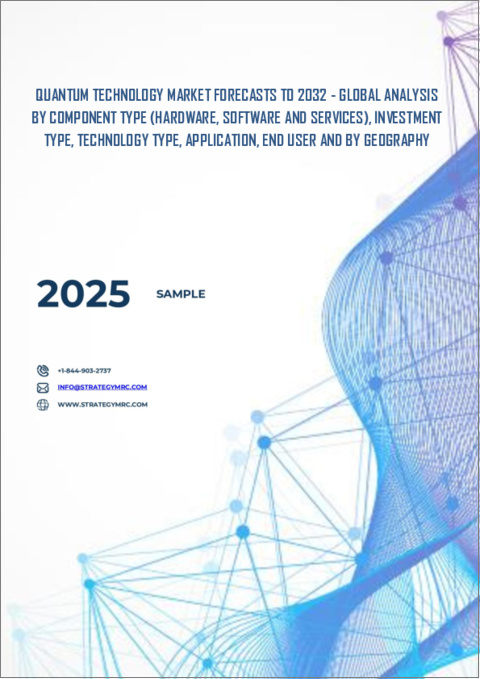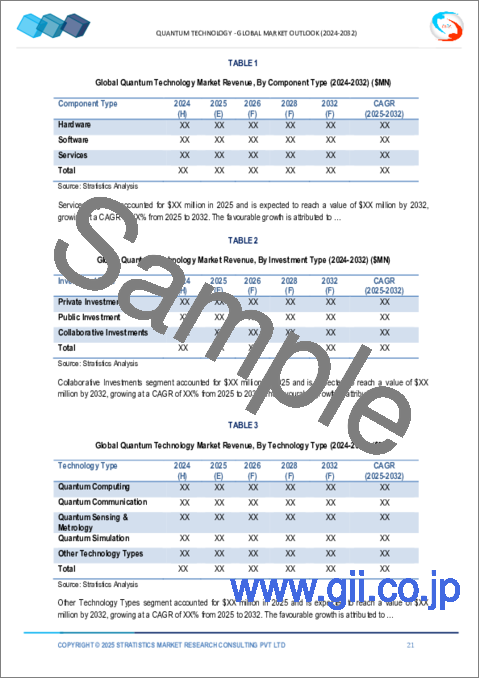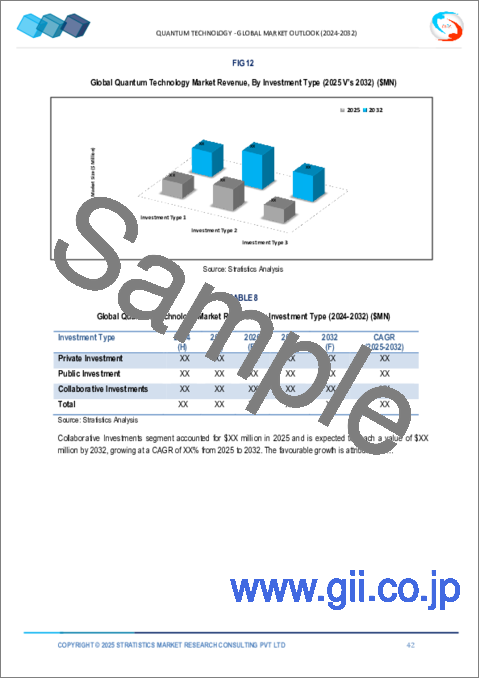|
|
市場調査レポート
商品コード
1700071
量子技術市場の2032年までの予測:コンポーネントタイプ、投資タイプ、技術タイプ、用途、エンドユーザー、地域別の世界分析Quantum Technology Market Forecasts to 2032 - Global Analysis By Component Type (Hardware, Software and Services), Investment Type, Technology Type, Application, End User and By Geography |
||||||
カスタマイズ可能
|
|||||||
| 量子技術市場の2032年までの予測:コンポーネントタイプ、投資タイプ、技術タイプ、用途、エンドユーザー、地域別の世界分析 |
|
出版日: 2025年04月03日
発行: Stratistics Market Research Consulting
ページ情報: 英文 200+ Pages
納期: 2~3営業日
|
- 全表示
- 概要
- 図表
- 目次
Stratistics MRCによると、世界の量子技術市場は2025年に16億2,900万米ドルを占め、予測期間中のCAGRは23.0%で成長し、2032年には69億3,830万米ドルに達すると予測されています。
量子技術は、原子や素粒子のエネルギーレベルという最小スケールの自然界の基本理論である量子力学の原理による一連の先端技術です。重ね合わせ、エンタングルメント、量子トンネルなどの量子現象を利用し、コンピューティング、暗号、センシング、通信などのセグメントで画期的なアプリケーションを開発します。量子技術は、データ処理、安全な通信、正確な計測などのセグメントで性能を向上させ、古典的な技術の能力を超えた複雑な問題を解決することを目指しており、産業全体のイノベーションを促進しています。
計算能力の向上に対する需要の高まり
市場における計算能力の向上に対する需要の高まりは、従来のコンピュータでは対応できない複雑な問題を解決する必要性によってもたらされています。製薬、材料科学、サイバーセキュリティなどの産業では、創薬、最適化、暗号化などの作業のために、より高速で強力な計算能力が必要とされています。量子技術の進化に伴い、膨大なデータを処理できる高性能量子コンピュータの需要は大きく伸びると予想されます。
キュービットの不安定性とエラー訂正
キュービットの不安定性と効果的なエラー訂正の必要性は、市場における大きな課題です。キュービットはノイズ、環境妨害、デコヒーレンスなどの影響を非常に受けやすく、量子計算のエラーにつながります。量子コンピュータの信頼性の高い性能を確保するためには、ロバストなエラー訂正技術の開発が不可欠です。産業が進歩するにつれ、これらの課題を克服することが、複雑な実世界のアプリケーションで量子技術の可能性を最大限に引き出す鍵となります。
量子通信インフラの進歩
量子通信インフラの進化は、超安全なデータ伝送を可能にし、市場に変革をもたらしつつあります。量子鍵分散(QKD)とエンタングルメントによる通信プロトコルの革新は、盗聴に強い安全なネットワークへの道を開いています。これらの進歩は、データセキュリティが最重要視される銀行、防衛、医療などの産業にとって極めて重要です。インフラが改善されるにつれ、量子通信システムの普及は世界のサイバーセキュリティとプライバシーを強化すると予想されます。
標準化の欠如
市場における標準化の欠如は、相互運用性を妨げ、進歩を遅らせる。確立されたプロトコルや統一されたガイドラインがなければ、異なる量子システムは通信や統合に苦労し、企業や研究機関の協力が制限される可能性があります。このようなセグメント化は、非効率やコスト増を招き、量子技術の普及を遅らせる。標準化は、互換性を確保し、技術革新を加速し、産業を超えた幅広い応用を可能にするために不可欠です。
COVID-19の影響
COVID-19のパンデミックは、研究プロジェクトを遅らせ、サプライチェーンを遅らせ、資源を量子技術開発からより緊急の公衆衛生問題へと振り向けることで、市場を混乱させました。しかし同時に、量子コンピューティングや量子通信を含む先端技術が、世界の課題に取り組む上で重要であることを浮き彫りにしました。その結果、パンデミック後の回復により、量子研究に対する関心と投資が再び高まり、このセグメントにおける長期的な革新と応用が加速しています。
予測期間中、量子シミュレーションセグメントが最大になる見込み
量子シミュレーションセグメントは、予測期間中に最大の市場シェアを占めると予想されています。材料科学、化学、創薬などのセグメントで応用されています。量子現象をシミュレートすることで、これらのシステムは分子間相互作用や材料特性について前例のないレベルの精度で洞察することができます。この能力は、先進的研究開発のための、より高速で正確なシミュレーションを可能にすることで、産業に革命をもたらすと期待されています。
予測期間中、航空宇宙・防衛セグメントのCAGRが最も高くなる見込み
予測期間中、航空宇宙・防衛セグメントが最も高い成長率を示すと予測されています。量子暗号は機密データ伝送に破られないセキュリティを提供し、量子センサはGPSが使えない環境での精度を高めています。さらに、量子コンピューティングは航空宇宙設計や防衛戦略のシミュレーションに革命をもたらす可能性を秘めています。これらの技術が成熟すれば、航空宇宙・防衛アプリケーションにおける運用能力、セキュリティ、意思決定が大幅に改善されることが期待されます。
最大シェアの地域
予測期間中、アジア太平洋が最大の市場シェアを占めると予想されます。アジア太平洋諸国は、量子コンピューティング、通信、暗号技術の発展に注力しており、政府が支援するイニシアティブや学術界と産業のコラボレーションが進んでいます。同地域は、通信、サイバーセキュリティ、製造業への応用により、量子研究の世界の拠点として台頭しており、世界の量子技術展望における重要な参入企業として位置づけられています。
CAGRが最も高い地域
予測期間中、北米地域が最も高いCAGRを示すと予測されています。政府、研究機関、非公開会社の協力により、量子コンピューティング、通信、センシングのインフラ開発と長期プロジェクトが確実なものとなっています。また、量子技術における世界の主導権争い、特に中国の躍進は、政府や企業が競合を維持するために投資を強化することを促しています。
無料カスタマイズサービス
本レポートをご購読の顧客には、以下の無料カスタマイズオプションのいずれかをご利用いただけます。
- 企業プロファイル
- 追加市場参入企業の包括的プロファイリング(3社まで)
- 主要企業のSWOT分析(3社まで)
- 地域セグメンテーション
- 顧客の関心に応じた主要国の市場推定・予測・CAGR(注:フィージビリティチェックによる)
- 競合ベンチマーキング
- 製品ポートフォリオ、地理的プレゼンス、戦略的提携による主要企業のベンチマーキング
目次
第1章 エグゼクティブサマリー
第2章 序文
- 概要
- ステークホルダー
- 調査範囲
- 調査手法
- データマイニング
- データ分析
- データ検証
- 調査アプローチ
- 調査資料
- 一次調査資料
- 一次調査資料
- 前提条件
第3章 市場動向分析
- イントロダクション
- 促進要因
- 抑制要因
- 機会
- 脅威
- 技術分析
- 用途分析
- エンドユーザー分析
- 新興市場
- COVID-19の影響
第4章 ポーターのファイブフォース分析
- 供給企業の交渉力
- 買い手の交渉力
- 代替品の脅威
- 新規参入業者の脅威
- 競争企業間の敵対関係
第5章 世界の量子技術市場:コンポーネントタイプ別
- イントロダクション
- ハードウェア
- 物理量子コンピュータ
- 極低温システム
- レーザーシステム
- 光学部品
- ソフトウェア
- アルゴリズム
- シミュレーションソフトウェア
- 量子クラウドプラットフォーム
- サービス
第6章 世界の量子技術市場:投資タイプ別
- イントロダクション
- 民間投資
- 公共投資
- 共同投資
第7章 世界の量子技術市場:技術タイプ別
- イントロダクション
- 量子コンピューティング
- 量子通信
- 量子センシングと計測
- 量子シミュレーション
- その他の技術タイプ
第8章 世界の量子技術市場:用途別
- イントロダクション
- 最適化問題
- 量子鍵配送(QKD)
- 温度・圧力センシング
- エネルギー効率
- 分子と化学シミュレーション
- スマートグリッド最適化
- その他
第9章 世界の量子技術市場:エンドユーザー別
- イントロダクション
- 医薬品
- 航空宇宙と防衛
- 通信
- 自動車
- エネルギー
- 金融サービス
- その他
第10章 世界の量子技術市場:地域別
- イントロダクション
- 北米
- 米国
- カナダ
- メキシコ
- 欧州
- ドイツ
- 英国
- イタリア
- フランス
- スペイン
- その他の欧州
- アジア太平洋
- 日本
- 中国
- インド
- オーストラリア
- ニュージーランド
- 韓国
- その他のアジア太平洋
- 南米
- アルゼンチン
- ブラジル
- チリ
- その他の南米
- 中東・アフリカ
- サウジアラビア
- アラブ首長国連邦
- カタール
- 南アフリカ
- その他の中東・アフリカ
第11章 主要開発
- 契約、パートナーシップ、コラボレーション、ジョイントベンチャー
- 買収と合併
- 新製品発売
- 事業拡大
- その他の主要戦略
第12章 企業プロファイリング
- IBM
- Toshiba Quantum Computing
- Photonic Systems Inc
- Microsoft
- Qutech
- Honeywell
- Alibaba Group
- Intel
- Amazon Web Services
- Rigetti Computing
- Bosch Quantum Sensing
- Xanadu
- Cambridge Quantum Computing
- Zapata Computing
List of Tables
- Table 1 Global Quantum Technology Market Outlook, By Region (2024-2032) ($MN)
- Table 2 Global Quantum Technology Market Outlook, By Component Type (2024-2032) ($MN)
- Table 3 Global Quantum Technology Market Outlook, By Hardware (2024-2032) ($MN)
- Table 4 Global Quantum Technology Market Outlook, By Physical Quantum Computers (2024-2032) ($MN)
- Table 5 Global Quantum Technology Market Outlook, By Cryogenic Systems (2024-2032) ($MN)
- Table 6 Global Quantum Technology Market Outlook, By Laser Systems (2024-2032) ($MN)
- Table 7 Global Quantum Technology Market Outlook, By Optical Components (2024-2032) ($MN)
- Table 8 Global Quantum Technology Market Outlook, By Software (2024-2032) ($MN)
- Table 9 Global Quantum Technology Market Outlook, By Algorithms (2024-2032) ($MN)
- Table 10 Global Quantum Technology Market Outlook, By Simulation Software (2024-2032) ($MN)
- Table 11 Global Quantum Technology Market Outlook, By Quantum Cloud Platforms (2024-2032) ($MN)
- Table 12 Global Quantum Technology Market Outlook, By Services (2024-2032) ($MN)
- Table 13 Global Quantum Technology Market Outlook, By Investment Type (2024-2032) ($MN)
- Table 14 Global Quantum Technology Market Outlook, By Private Investment (2024-2032) ($MN)
- Table 15 Global Quantum Technology Market Outlook, By Public Investment (2024-2032) ($MN)
- Table 16 Global Quantum Technology Market Outlook, By Collaborative Investments (2024-2032) ($MN)
- Table 17 Global Quantum Technology Market Outlook, By Technology Type (2024-2032) ($MN)
- Table 18 Global Quantum Technology Market Outlook, By Quantum Computing (2024-2032) ($MN)
- Table 19 Global Quantum Technology Market Outlook, By Quantum Communication (2024-2032) ($MN)
- Table 20 Global Quantum Technology Market Outlook, By Quantum Sensing & Metrology (2024-2032) ($MN)
- Table 21 Global Quantum Technology Market Outlook, By Quantum Simulation (2024-2032) ($MN)
- Table 22 Global Quantum Technology Market Outlook, By Other Technology Types (2024-2032) ($MN)
- Table 23 Global Quantum Technology Market Outlook, By Application (2024-2032) ($MN)
- Table 24 Global Quantum Technology Market Outlook, By Optimization Problems (2024-2032) ($MN)
- Table 25 Global Quantum Technology Market Outlook, By Quantum Key Distribution (QKD) (2024-2032) ($MN)
- Table 26 Global Quantum Technology Market Outlook, By Temperature & Pressure Sensing (2024-2032) ($MN)
- Table 27 Global Quantum Technology Market Outlook, By Energy Efficiency (2024-2032) ($MN)
- Table 28 Global Quantum Technology Market Outlook, By Molecular & Chemical Simulations (2024-2032) ($MN)
- Table 29 Global Quantum Technology Market Outlook, By Smart Grid Optimization (2024-2032) ($MN)
- Table 30 Global Quantum Technology Market Outlook, By Other Applications (2024-2032) ($MN)
- Table 31 Global Quantum Technology Market Outlook, By End User (2024-2032) ($MN)
- Table 32 Global Quantum Technology Market Outlook, By Pharmaceuticals (2024-2032) ($MN)
- Table 33 Global Quantum Technology Market Outlook, By Aerospace & Defense (2024-2032) ($MN)
- Table 34 Global Quantum Technology Market Outlook, By Telecommunications (2024-2032) ($MN)
- Table 35 Global Quantum Technology Market Outlook, By Automotive (2024-2032) ($MN)
- Table 36 Global Quantum Technology Market Outlook, By Energy (2024-2032) ($MN)
- Table 37 Global Quantum Technology Market Outlook, By Financial Services (2024-2032) ($MN)
- Table 38 Global Quantum Technology Market Outlook, By Other End Users (2024-2032) ($MN)
Note: Tables for North America, Europe, APAC, South America, and Middle East & Africa Regions are also represented in the same manner as above.
According to Stratistics MRC, the Global Quantum Technology Market is accounted for $1629.0 million in 2025 and is expected to reach $6938.3 million by 2032 growing at a CAGR of 23.0% during the forecast period. Quantum technology is a set of advanced technologies based on the principles of quantum mechanics, the fundamental theory of nature at the smallest scales of energy levels of atoms and subatomic particles. It involves harnessing quantum phenomena like superposition, entanglement, and quantum tunneling to develop groundbreaking applications in fields such as computing, cryptography, sensing, and communications. Quantum technologies aim to solve complex problems beyond the capability of classical technologies, offering enhanced performance in areas like data processing, secure communication, and precise measurement, thus driving innovation across industries.
Market Dynamics:
Driver:
Rising demand for enhanced computational power
The rising demand for enhanced computational power in the market is driven by the need to solve complex problems that classical computers cannot handle. Industries such as pharmaceuticals, materials science, and cybersecurity require faster and more powerful computing capabilities for tasks like drug discovery, optimization, and encryption. As quantum technologies evolve, the demand for high-performance quantum computers capable of processing vast amounts of data is expected to grow significantly.
Restraint:
Qubit instability and error correction
Qubit instability and the need for effective error correction are major challenges in the market. Qubits are highly susceptible to noise, environmental disturbances, and decoherence, leading to errors in quantum computations. Developing robust error-correction techniques is crucial for ensuring reliable performance in quantum computers. As the industry progresses, overcoming these challenges is key to unlocking the full potential of quantum technology for complex, real-world applications.
Opportunity:
Advancements in quantum communication infrastructure
Advancements in quantum communication infrastructure are transforming the market by enabling ultra-secure data transmission. Innovations in quantum key distribution (QKD) and entanglement-based communication protocols are paving the way for secure networks resistant to eavesdropping. These advancements are crucial for industries such as banking, defense, and healthcare, where data security is paramount. As infrastructure improves, the widespread adoption of quantum communication systems is expected to enhance global cybersecurity and privacy.
Threat:
Lack of standardization
The lack of standardization in the market hinders interoperability and slows progress. Without established protocols and uniform guidelines, different quantum systems may struggle to communicate or integrate, limiting collaboration across companies and research institutions. This fragmentation can lead to inefficiencies, increased costs, and slower adoption of quantum technologies. Standardization is essential for ensuring compatibility, accelerating innovation, and enabling broader application across industries.
Covid-19 Impact:
The COVID-19 pandemic disrupted the market by delaying research projects, slowing down supply chains, and diverting resources away from quantum development towards more immediate public health concerns. However, it also highlighted the importance of advanced technologies, including quantum computing and communications, in addressing global challenges. As a result, post-pandemic recovery has seen renewed interest and investment in quantum research, accelerating long-term innovation and applications in the field.
The quantum simulation segment is expected to be the largest during the forecast period
The quantum simulation segment is expected to account for the largest market share during the forecast period. It has applications in fields like material science, chemistry, and drug discovery. By simulating quantum phenomena, these systems can provide insights into molecular interactions and material properties at an unprecedented level of precision. This capability is expected to revolutionize industries by enabling faster, more accurate simulations for advanced research and development.
The aerospace & defense segment is expected to have the highest CAGR during the forecast period
Over the forecast period, the aerospace & defense segment is predicted to witness the highest growth rate. Quantum encryption can provide unbreakable security for sensitive data transmission, while quantum sensors enhance precision in GPS-denied environments. Additionally, quantum computing has the potential to revolutionize simulations for aerospace design and defense strategy. As these technologies mature, they promise to significantly improve operational capabilities, security, and decision-making in aerospace and defense applications.
Region with largest share:
During the forecast period, the Asia Pacific region is expected to hold the largest market share. These nations are focusing on advancing quantum computing, communication, and cryptography, with government-backed initiatives and collaborations between academia and industry. The region is emerging as a global hub for quantum research, with applications in telecommunications, cybersecurity, and manufacturing, positioning itself as a key player in the global quantum technology landscape.
Region with highest CAGR:
Over the forecast period, the North America region is anticipated to exhibit the highest CAGR. Collaborations between governments, research organizations, and private companies ensure the development of infrastructure and long-term projects in quantum computing, communication, and sensing. Additionally, the race for global leadership in quantum technologies, particularly with China making significant strides, has prompted governments and companies to ramp up their investments to stay competitive.
Key players in the market
Some of the key players in Quantum Technology Market include IBM, Toshiba Quantum Computing, Google, Photonic Systems Inc, Microsoft, Qutech, Honeywell, Alibaba Group, Intel, Amazon Web Services, Rigetti Computing, Bosch Quantum Sensing, Xanadu, Cambridge Quantum Computing and Zapata Computing.
Key Developments:
In November 2024, IBM announced quantum hardware and software advancements to execute complex algorithms on IBM quantum computers with record levels of scale, speed, and accuracy. IBM Quantum Heron, the company's most performant quantum processor to-date and available in IBM's global quantum data centers, can now leverage Qiskit to accurately run certain classes of quantum circuits with up to 5,000 two-qubit gate operations..
In April 2024, Toshiba Digital Solutions Corporation has announced partnership with KT Corporation (KT), has demonstrated how banks and financial networks can be protected from cyberattacks by quantum computers by bringing hybrid quantum secure communications, comprising quantum key distribution (QKD)*1 and post-quantum cryptography (PQC)*2, to secure communications at Shinhan Bank, one of South Korea's leading banks.
Component Types Covered:
- Hardware
- Software
- Services
Investment Types Covered:
- Private Investment
- Public Investment
- Collaborative Investments
Technology Types Covered:
- Quantum Computing
- Quantum Communication
- Quantum Sensing & Metrology
- Quantum Simulation
- Other Technology Types
Applications Covered:
- Optimization Problems
- Quantum Key Distribution (QKD)
- Temperature & Pressure Sensing
- Energy Efficiency
- Molecular & Chemical Simulations
- Smart Grid Optimization
- Other Applications
End Users Covered:
- Pharmaceuticals
- Aerospace & Defense
- Telecommunications
- Automotive
- Energy
- Financial Services
- Other End Users
Regions Covered:
- North America
- US
- Canada
- Mexico
- Europe
- Germany
- UK
- Italy
- France
- Spain
- Rest of Europe
- Asia Pacific
- Japan
- China
- India
- Australia
- New Zealand
- South Korea
- Rest of Asia Pacific
- South America
- Argentina
- Brazil
- Chile
- Rest of South America
- Middle East & Africa
- Saudi Arabia
- UAE
- Qatar
- South Africa
- Rest of Middle East & Africa
What our report offers:
- Market share assessments for the regional and country-level segments
- Strategic recommendations for the new entrants
- Covers Market data for the years 2024, 2025, 2026, 2028, and 2032
- Market Trends (Drivers, Constraints, Opportunities, Threats, Challenges, Investment Opportunities, and recommendations)
- Strategic recommendations in key business segments based on the market estimations
- Competitive landscaping mapping the key common trends
- Company profiling with detailed strategies, financials, and recent developments
- Supply chain trends mapping the latest technological advancements
Free Customization Offerings:
All the customers of this report will be entitled to receive one of the following free customization options:
- Company Profiling
- Comprehensive profiling of additional market players (up to 3)
- SWOT Analysis of key players (up to 3)
- Regional Segmentation
- Market estimations, Forecasts and CAGR of any prominent country as per the client's interest (Note: Depends on feasibility check)
- Competitive Benchmarking
- Benchmarking of key players based on product portfolio, geographical presence, and strategic alliances
Table of Contents
1 Executive Summary
2 Preface
- 2.1 Abstract
- 2.2 Stake Holders
- 2.3 Research Scope
- 2.4 Research Methodology
- 2.4.1 Data Mining
- 2.4.2 Data Analysis
- 2.4.3 Data Validation
- 2.4.4 Research Approach
- 2.5 Research Sources
- 2.5.1 Primary Research Sources
- 2.5.2 Secondary Research Sources
- 2.5.3 Assumptions
3 Market Trend Analysis
- 3.1 Introduction
- 3.2 Drivers
- 3.3 Restraints
- 3.4 Opportunities
- 3.5 Threats
- 3.6 Technology Analysis
- 3.7 Application Analysis
- 3.8 End User Analysis
- 3.9 Emerging Markets
- 3.10 Impact of Covid-19
4 Porters Five Force Analysis
- 4.1 Bargaining power of suppliers
- 4.2 Bargaining power of buyers
- 4.3 Threat of substitutes
- 4.4 Threat of new entrants
- 4.5 Competitive rivalry
5 Global Quantum Technology Market, By Component Type
- 5.1 Introduction
- 5.2 Hardware
- 5.2.1 Physical Quantum Computers
- 5.2.2 Cryogenic Systems
- 5.2.3 Laser Systems
- 5.2.4 Optical Components
- 5.3 Software
- 5.3.1 Algorithms
- 5.3.2 Simulation Software
- 5.3.3 Quantum Cloud Platforms
- 5.4 Services
6 Global Quantum Technology Market, By Investment Type
- 6.1 Introduction
- 6.2 Private Investment
- 6.3 Public Investment
- 6.4 Collaborative Investments
7 Global Quantum Technology Market, By Technology Type
- 7.1 Introduction
- 7.2 Quantum Computing
- 7.3 Quantum Communication
- 7.4 Quantum Sensing & Metrology
- 7.5 Quantum Simulation
- 7.6 Other Technology Types
8 Global Quantum Technology Market, By Application
- 8.1 Introduction
- 8.2 Optimization Problems
- 8.3 Quantum Key Distribution (QKD)
- 8.4 Temperature & Pressure Sensing
- 8.5 Energy Efficiency
- 8.6 Molecular & Chemical Simulations
- 8.7 Smart Grid Optimization
- 8.8 Other Applications
9 Global Quantum Technology Market, By End User
- 9.1 Introduction
- 9.2 Pharmaceuticals
- 9.3 Aerospace & Defense
- 9.4 Telecommunications
- 9.5 Automotive
- 9.6 Energy
- 9.7 Financial Services
- 9.8 Other End Users
10 Global Quantum Technology Market, By Geography
- 10.1 Introduction
- 10.2 North America
- 10.2.1 US
- 10.2.2 Canada
- 10.2.3 Mexico
- 10.3 Europe
- 10.3.1 Germany
- 10.3.2 UK
- 10.3.3 Italy
- 10.3.4 France
- 10.3.5 Spain
- 10.3.6 Rest of Europe
- 10.4 Asia Pacific
- 10.4.1 Japan
- 10.4.2 China
- 10.4.3 India
- 10.4.4 Australia
- 10.4.5 New Zealand
- 10.4.6 South Korea
- 10.4.7 Rest of Asia Pacific
- 10.5 South America
- 10.5.1 Argentina
- 10.5.2 Brazil
- 10.5.3 Chile
- 10.5.4 Rest of South America
- 10.6 Middle East & Africa
- 10.6.1 Saudi Arabia
- 10.6.2 UAE
- 10.6.3 Qatar
- 10.6.4 South Africa
- 10.6.5 Rest of Middle East & Africa
11 Key Developments
- 11.1 Agreements, Partnerships, Collaborations and Joint Ventures
- 11.2 Acquisitions & Mergers
- 11.3 New Product Launch
- 11.4 Expansions
- 11.5 Other Key Strategies
12 Company Profiling
- 12.1 IBM
- 12.2 Toshiba Quantum Computing
- 12.3 Google
- 12.4 Photonic Systems Inc
- 12.5 Microsoft
- 12.6 Qutech
- 12.7 Honeywell
- 12.8 Alibaba Group
- 12.9 Intel
- 12.10 Amazon Web Services
- 12.11 Rigetti Computing
- 12.12 Bosch Quantum Sensing
- 12.13 Xanadu
- 12.14 Cambridge Quantum Computing
- 12.15 Zapata Computing






